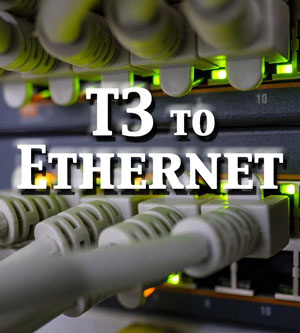Not long ago, T3 voice and data lines were a mainstay of medium and larger size businesses. Today, that once impressive 45 Mbps doesn’t seem all that fast. Our business applications demand more like 100 Mbps or 1,000 Mbps. Medical campuses, design firms and video production houses are more interested in 10 Gbps and looking beyond even that. If you still have a T3 line contract, you may well find that you can get more bandwidth for the same or less cost right now.
 What is a T3 Line?
What is a T3 Line?The T3 designation is part of the T-Carrier system developed by Bell Labs in the post-war tech boom. It was originally designed to transport large numbers of simultaneous telephone conversations and still fills that role for some larger businesses and call centers. Prior to T-Carrier, telecom was based on analog technology. T1 and T3 changed that to digital and started us down the path to the Internet we have today.
T3 is specified at 45 Mbps, enough to transport 672 digitized phone calls. That makes it a lot more efficient than creating a bundle of 672 separate twisted pair copper wires as telephone lines. T3 was once transported through large coaxial cables or microwave relay stations. More recently, it has been bundled on SONET fiber optic cables and called DS3. DS3 is the data format that runs on the physical T3 line, so DS3 and T3 pretty much mean the same thing.
The channelized version of T3 is used to carry those 672 phone calls, each in a separate channel or time slot in the data stream. For data transmission, the unchannelized version of T3 carries 45 Mbps worth of data, including the familiar packet switched networks.
Ethernet Replaces T3
Most all communications these days done over digital networks and originates in the most popular protocol, Ethernet. Even telephones have switched to an Ethernet interface so they can hook to the same network as computers instead of having separate wiring. This is called VoIP or Voice over Internet Protocol. With computers and phones on the same network, it makes sense to transport everything over Ethernet on both the local and wide area networks.
This is exactly what is happening. Carrier Ethernet, the long haul version, is replacing other telecom protocols such as T-Carrier for copper line and SONET for fiber optic. It’s pretty much going all Fiber optic Ethernet now. This is often referred to as Ethernet WAN for Wide Area Network.
Cost and Performance Advantages of Ethernet
The first advantage of long haul Ethernet transmission is that it is directly compatible with most all company networks. You simply plug the Carrier’s Ethernet into your router. There is no need for separate protocol conversion boxes or modules as required to support T1 and T3 lines.
A second advantage is that Ethernet is easily scalable. You can run at any speed up to the limit of the physical port from the Carrier. T-Carrier and SONET protocols were designed for specific speeds and needed to have hardware replaced to upgrade. The bandwidth of your line is set by the Carrier based on your contract. You can easily increase or decrease that as your needs change and it will be reflected in your billing.
Perhaps the biggest incentive to switch to Ethernet WAN service is pricing. You may be shocked at how much your can save by switching from an older telecom service to Ethernet WAN. Ethernet is almost always lower in cost on a per-Mbps basis. Sometimes the difference can be a factor of two or more.
Much of the cost savings comes from a more competitive environment for fiber optic Ethernet versus the old telco services with one provider. There may be several companies offering Ethernet bandwidth for your business at competitive rates.
Fiber is also more available than ever before. The upgrade of cellphone towers to 4G LTE and 5G has demanded a rapid expansion of fiber optic networks. Copper is yesterday’s news and, more and more, it is being left to rust in the ground. Fiber and wireless are the future for networking.
Do you have legacy T3 or DS3 service and want to see if you can get a better deal? That’s easy. Just check prices and availability of Ethernet WAN service for your business address. Chances are good that you can get more bandwidth for the same or less cost than what you pay now.
